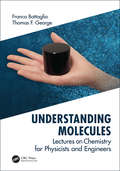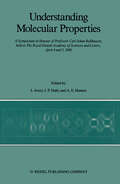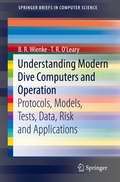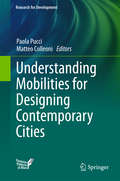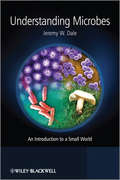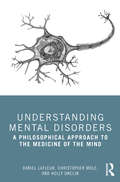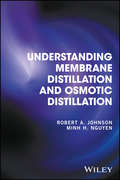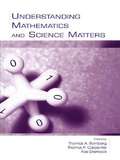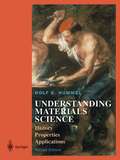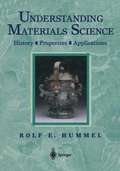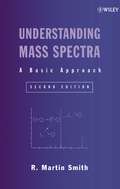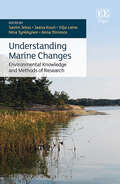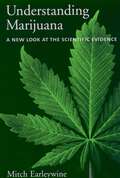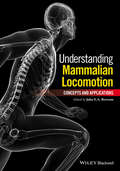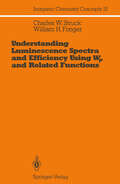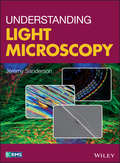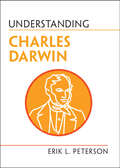- Table View
- List View
Understanding Molecules: Lectures on Chemistry for Physicists and Engineers
by Franco Battaglia Thomas F. GeorgeChemistry is a subject that many students with differing goals have to tackle. This unique general chemistry textbook is tailored to more mathematically-oriented engineering or physics students. The authors emphasize the principles underlying chemistry rather than chemistry itself and the almost encyclopedic completeness appearing in a common textbook of general chemistry is sacrificed for an emphasis to these principles. Contained within 300 pages, it is suitable for a one-semester course for students who have a strong background in calculus. Over 200 problems with answers are provided so that the students can check their progress.
Understanding Molecules: Lectures on Chemistry for Physicists and Engineers
by Franco Battaglia Thomas F. GeorgeChemistry is a subject that many students with differing goals have to tackle. This unique general chemistry textbook is tailored to more mathematically-oriented engineering or physics students. The authors emphasize the principles underlying chemistry rather than chemistry itself and the almost encyclopedic completeness appearing in a common textbook of general chemistry is sacrificed for an emphasis to these principles. Contained within 300 pages, it is suitable for a one-semester course for students who have a strong background in calculus. Over 200 problems with answers are provided so that the students can check their progress.
Understanding Molecular Properties: A Symposium in Honour of Professor Carl Johan Ballhausen, held at The Royal Danish Academy of Sciences and Letters, April 4 and 5, 1986
by John S. Avery Jens Peder Dahl Paul R. Hansen"The Theory of Atomic Spectra", surrrrnanzlllg all that was then known about the quantum theory of free atoms; and in 1961, J.S. Griffith published "The Theory of Transition Metal Ions", in which he combined the ideas in Condon and Shortley's book with those of Bethe, Schlapp, Penney and Van Vleck. All this work, however, was done by physicists, and the results were reported in a way which was more accessable to physicists than to chemists. In the meantime, Carl J. Ballhausen had been studying quantum theory with W. Moffitt at Harvard; and in 1962 (almost simultaneously with Griffith) he published his extremely important book, "Introduction to Ligand Field Theory". This influential book was written from the standpoint of a chemist, and it became the standard work from which chemists learned the quantum theory of transition metal complexes. While it treated in detail the group theoretical aspects of crystal field theory, Carl J. Ballhausen's book also emphasized the limitations of the theory. As he pointed out, it is often not sufficient to treat the central metal ion as free (apart from the influence of the charges on the surrounding ligands): - In many cases hybridization of metal and ligand orbitals is significant. Thus, in general. a molecular orbital treatment is needed to describe transition metal complexes. However, much of the group theory developed In connection with crystal field theory can also be used in the molecular orbital treatment.
Understanding Modern Dive Computers and Operation: Protocols, Models, Tests, Data, Risk and Applications (SpringerBriefs in Computer Science)
by B. R. Wienke T. R. O'LearyThis brief provides a complete yet concise description of modern dive computers and their operations to date in one source with coupled applications for added understanding. Basic diving principles are detailed with practical computer implementations. Interrelated topics to diving protocols and operational procedures are included. Tests, statistics and correlations of computer models with data are underscored. The exposition also links phase mechanics to dissolved gases in modern decompression theory with mathematical relationships and equations used in dive computer synthesis. Applications focus upon and mimic dive computer operations within model implementations for added understanding.This comprehensive resource includes a complete list of dive computers that are marketed and their staging models, as well as a complete list of diveware marketed and their staging algorithms, linkage of pertinent wet and dry tests to modern computer algorithms, a description of two basic computer models with all constants and parameters, mathematical ansatz of on-the-fly risk for surfacing at any dive depth, detailing of statistical techniques used to validate dive computers from data, and a description of profile Data Banks for computer dive model correlations.The book will find an audience amongst computer scientists, doctors, underwater researchers, engineers, physical and biosciences diving professionals, explorers, chamber technicians, physiologists and technical and recreational divers.
Understanding Mobilities for Designing Contemporary Cities (Research for Development)
by Paola Pucci Matteo ColleoniThis book explores mobilities as a key to understanding the practices that both frame and generate contemporary everyday life in the urban context. At the same time, it investigates the challenges arising from the interpretation of mobility as a socio-spatial phenomenon both in the social sciences and in urban studies. Leading sociologists, economists, urban planners and architects address the ways in which spatial mobilities contribute to producing diversified uses of the city and describe forms and rhythms of different life practices, including unexpected uses and conflicts. The individual sections of the book focus on the role of mobility in transforming contemporary cities; the consequences of interpreting mobility as a socio-spatial phenomenon for urban projects and policies; the conflicts and inequalities generated by the co-presence of different populations due to mobility and by the interests gathered around major mobility projects; and the use of new data and mapping of mobilities to enhance comprehension of cities. The theoretical discussion is complemented by references to practical experiences, helping readers gain a broader understanding of mobilities in relation to the capacity to analyze, plan and design contemporary cities.
Understanding Microbes: An Introduction to a Small World
by Jeremy W. DaleWe can’t see them, but microbes are the dominant form of life on Earth. They make up half of the world’s biomass. They were here billions of years before we were, and they will be here after we are gone. Without their activity, life as we know it would be impossible. Even within our own bodies, there are ten times as many bacterial cells as human cells. Understanding Microbes provides a clear, accessible introduction to this world of microbes. As well as looking at a selection of infectious diseases, including how they are prevented and treated, the book explores the importance of microbes in the environment, in the production and preservation of food, and their applications in biotechnology. This lively and engaging book provides the basics of microbiology, in a contemporary context. It will be equally useful for students across the biological, environmental and health sciences, and for the curious reader wanting to learn more about this fascinating subject. A highly-readable, concise introduction to the basics of microbiology placed in the context of the very latest developments in molecular biology and their impact on the microbial world. Numerous real-world examples range from how cows digest grass to the role of microbes in cancer and the impact of climate change Well-illustrated in full colour throughout. Written by an Author with a proven track record in teaching, writing and research.
Understanding Microbes: An Introduction to a Small World
by Jeremy W. DaleWe can’t see them, but microbes are the dominant form of life on Earth. They make up half of the world’s biomass. They were here billions of years before we were, and they will be here after we are gone. Without their activity, life as we know it would be impossible. Even within our own bodies, there are ten times as many bacterial cells as human cells. Understanding Microbes provides a clear, accessible introduction to this world of microbes. As well as looking at a selection of infectious diseases, including how they are prevented and treated, the book explores the importance of microbes in the environment, in the production and preservation of food, and their applications in biotechnology. This lively and engaging book provides the basics of microbiology, in a contemporary context. It will be equally useful for students across the biological, environmental and health sciences, and for the curious reader wanting to learn more about this fascinating subject. A highly-readable, concise introduction to the basics of microbiology placed in the context of the very latest developments in molecular biology and their impact on the microbial world. Numerous real-world examples range from how cows digest grass to the role of microbes in cancer and the impact of climate change Well-illustrated in full colour throughout. Written by an Author with a proven track record in teaching, writing and research.
Understanding Mental Disorders: A Philosophical Approach to the Medicine of the Mind
by Daniel Lafleur Christopher Mole Holly OnclinUnderstanding Mental Disorders aims to help current and future psychiatrists, and those who work with them, to think critically about the ethical, conceptual, and methodological questions that are raised by the theory and practice of psychiatry. It considers questions that concern the mind’s relationship to the brain, the origins of our norms for thinking and behavior, and the place of psychiatry in medicine, and in society more generally. With a focus on the current debates around psychiatry’s diagnostic categories, the authors ask where these categories come from, if psychiatry should be looking to find new categories that are based more immediately on observations of the brain, and whether psychiatrists need to employ any diagnostic categories at all. The book is a unique guide for readers who want to think carefully about the mind, mental disorders, and the practice of psychiatric medicine.
Understanding Mental Disorders: A Philosophical Approach to the Medicine of the Mind
by Daniel Lafleur Christopher Mole Holly OnclinUnderstanding Mental Disorders aims to help current and future psychiatrists, and those who work with them, to think critically about the ethical, conceptual, and methodological questions that are raised by the theory and practice of psychiatry. It considers questions that concern the mind’s relationship to the brain, the origins of our norms for thinking and behavior, and the place of psychiatry in medicine, and in society more generally. With a focus on the current debates around psychiatry’s diagnostic categories, the authors ask where these categories come from, if psychiatry should be looking to find new categories that are based more immediately on observations of the brain, and whether psychiatrists need to employ any diagnostic categories at all. The book is a unique guide for readers who want to think carefully about the mind, mental disorders, and the practice of psychiatric medicine.
Understanding Membrane Distillation and Osmotic Distillation
by Robert A. Johnson Minh H. NguyenThis book addresses principles and practical applications of membrane distillation and osmotic distillation, separation technologies which are gaining increasing attention due to their advantages over conventional concentration processes.• Addresses membrane and osmotic distillation, two closely related and novel processes that offer several advantages over conventional concentration processes• Has a widespread impact and application of the technology in industries such as food, environment, and nuclear clean-up / containment• Covers theoretical aspects of both processes, the properties of hydrophobic membranes, process economics, integrated processes and future prospects.• Caters the presentation caters for the diversity of readership with respect to links with membrane technologies.
Understanding Membrane Distillation and Osmotic Distillation
by Robert A. Johnson Minh H. NguyenThis book addresses principles and practical applications of membrane distillation and osmotic distillation, separation technologies which are gaining increasing attention due to their advantages over conventional concentration processes.• Addresses membrane and osmotic distillation, two closely related and novel processes that offer several advantages over conventional concentration processes• Has a widespread impact and application of the technology in industries such as food, environment, and nuclear clean-up / containment• Covers theoretical aspects of both processes, the properties of hydrophobic membranes, process economics, integrated processes and future prospects.• Caters the presentation caters for the diversity of readership with respect to links with membrane technologies.
Understanding Mathematics and Science Matters (Studies in Mathematical Thinking and Learning Series)
by Thomas A. Romberg Thomas P. Carpenter Fae DremockThe research reported in this book provides reliable evidence on and knowledge about mathematics and science instruction that emphasizes student understanding--instruction consistent with the needs of students who will be citizens in an increasingly demanding technological world.The National Center for Improving Student Learning in Mathematics and Science--established in 1996 as a research center and funded by the U.S. Department of Education--was instrumental in developing instructional practices supportive of high student achievement in and understanding of mathematics and science concepts. NCISLA researchers worked with teachers, students, and administrators to construct learning environments that exemplify current research and theory about effective learning of mathematics and science. The careful programs of research conducted examined how instructional content and design, assessment, professional development, and organizational support can be designed, implemented, and orchestrated to support the learning of all students. This book presents a summary of the concepts, findings, and conclusions of the Center's research from 1996-2001.In the Introduction, the chapters in Understanding Mathematics and Science Matters are situated in terms of the reform movement in school mathematics and school science. Three thematically structured sections focus on, respectively, research directed toward what is involved when students learn mathematics and science with understanding; research on the role of teachers and the problems they face when attempting to teach their students mathematics and science with understanding; and a collaboration among some of the contributors to this volume to gather information about classroom assessment practices and organizational support for reform.The goal of this book is to help educational practitioners, policymakers, and the general public to see the validity of the reform recommendations, understand the recommended guidelines, and to use these to transform teaching and learning of mathematics and science in U.S. classrooms.
Understanding Mathematics and Science Matters (Studies in Mathematical Thinking and Learning Series)
by Thomas A. Romberg Thomas P. Carpenter Fae DremockThe research reported in this book provides reliable evidence on and knowledge about mathematics and science instruction that emphasizes student understanding--instruction consistent with the needs of students who will be citizens in an increasingly demanding technological world.The National Center for Improving Student Learning in Mathematics and Science--established in 1996 as a research center and funded by the U.S. Department of Education--was instrumental in developing instructional practices supportive of high student achievement in and understanding of mathematics and science concepts. NCISLA researchers worked with teachers, students, and administrators to construct learning environments that exemplify current research and theory about effective learning of mathematics and science. The careful programs of research conducted examined how instructional content and design, assessment, professional development, and organizational support can be designed, implemented, and orchestrated to support the learning of all students. This book presents a summary of the concepts, findings, and conclusions of the Center's research from 1996-2001.In the Introduction, the chapters in Understanding Mathematics and Science Matters are situated in terms of the reform movement in school mathematics and school science. Three thematically structured sections focus on, respectively, research directed toward what is involved when students learn mathematics and science with understanding; research on the role of teachers and the problems they face when attempting to teach their students mathematics and science with understanding; and a collaboration among some of the contributors to this volume to gather information about classroom assessment practices and organizational support for reform.The goal of this book is to help educational practitioners, policymakers, and the general public to see the validity of the reform recommendations, understand the recommended guidelines, and to use these to transform teaching and learning of mathematics and science in U.S. classrooms.
Understanding Materials Science: History, Properties, Applications, Second Edition
by Rolf E. HummelThis introduction for engineers examines not only the physical properties of materials, but also their history, uses, development, and some of the implications of resource depletion and materials substitutions.
Understanding Materials Science: History · Properties · Applications
by Rolf E. HummelThis introduction for engineers examines not only the physical properties of materials, but also their history, uses, development, and some of the implications of resource depletion and materials substitutions.
Understanding Mass Spectra: A Basic Approach
by R. Martin SmithUnderstanding Mass Spectra: A Basic Approach, Second Edition combines coverage of the principles underlying mass spectral analysis with clear guidelines on how to apply them in a laboratory setting. Completely revised from the first edition, an updated and unified approach to mass spectral interpretation emphasizes the application of basic principles from undergraduate organic, analytical, and physical chemistry courses. A detailed overview of theory and instrumentation, this useful guide contains step-by-step descriptions of interpretative strategies and convenient lists and tables detailing the information needed to solve unknowns. Other features include real-world case studies and examples, skill-building problems with clearly explained answers, and easy-to-follow explanations of the important mathematical derivations.
Understanding Marine Changes: Environmental Knowledge and Methods of Research
Studying environmental changes to the seas and oceans through a variety of perspectives and disciplines, this pioneering book outlines the challenges of researching marine environmental issues.With no linear cause-and-effect relationship between marine environmental changes and the often human-induced stressors which produce them, the changes to our seas and oceans are complex and uncertain, arising from multiple and interconnected issues. Bringing together academic expertise from different fields of study, this innovative book engages with stakeholders and branches of local ecological knowledge to address marine changes, outlining how they must be studied from multiple perspectives rather than a single academic discipline to reach effective solutions. Discussing marine interdisciplinarity in action, the book features international case studies from diverse fields across the ocean sciences, humanities and social sciences that explore art and science collaborations in practice.Showcasing the practical challenges and opportunities of such research, this will prove an invigorating read for students and scholars across such subject areas as environmental governance and regulation, marine and ocean sciences, sustainability studies and climate change. Its findings will also be of use to policymakers and practitioners concerned with marine changes across the world.
Understanding Marijuana: A New Look at the Scientific Evidence
by Mitch EarleywineMarijuana is the world's most popular illicit drug, with hundreds of millions of regular users worldwide. One in three Americans has smoked pot at least once. The Drug Enforcement Agency estimates that Americans smoke five million pounds of marijuana each year. And yet marijuana remains largely misunderstood by both its advocates and its detractors. To some, marijuana is an insidious "stepping-stone" drug, enticing the inexperienced and paving the way to the inevitable abuse of harder drugs. To others, medical marijuana is an organic means of easing the discomfort or stimulating the appetite of the gravely ill. Others still view marijuana, like alcohol, as a largely harmless indulgence, dangerous only when used immoderately. All sides of the debate have appropriated the scientific evidence on marijuana to satisfy their claims. What then are we to make of these conflicting portrayals of a drug with historical origins dating back to 8,000 B.C.? Understanding Marijuana examines the biological, psychological, and societal impact of this controversial substance. What are the effects, for mind and body, of long-term use? Are smokers of marijuana more likely than non-users to abuse cocaine and heroine? What effect has the increasing potency of marijuana in recent years had on users and on use? Does our current legal policy toward marijuana make sense? Earleywine separates science from opinion to show how marijuana defies easy dichotomies. Tracing the medical and political debates surrounding marijuana in a balanced, objective fashion, this book will be the definitive primer on our most controversial and widely used illicit substance.
Understanding Marijuana: A New Look at the Scientific Evidence
by Mitch EarleywineMarijuana is the world's most popular illicit drug, with hundreds of millions of regular users worldwide. One in three Americans has smoked pot at least once. The Drug Enforcement Agency estimates that Americans smoke five million pounds of marijuana each year. And yet marijuana remains largely misunderstood by both its advocates and its detractors. To some, marijuana is an insidious "stepping-stone" drug, enticing the inexperienced and paving the way to the inevitable abuse of harder drugs. To others, medical marijuana is an organic means of easing the discomfort or stimulating the appetite of the gravely ill. Others still view marijuana, like alcohol, as a largely harmless indulgence, dangerous only when used immoderately. All sides of the debate have appropriated the scientific evidence on marijuana to satisfy their claims. What then are we to make of these conflicting portrayals of a drug with historical origins dating back to 8,000 B.C.? Understanding Marijuana examines the biological, psychological, and societal impact of this controversial substance. What are the effects, for mind and body, of long-term use? Are smokers of marijuana more likely than non-users to abuse cocaine and heroine? What effect has the increasing potency of marijuana in recent years had on users and on use? Does our current legal policy toward marijuana make sense? Earleywine separates science from opinion to show how marijuana defies easy dichotomies. Tracing the medical and political debates surrounding marijuana in a balanced, objective fashion, this book will be the definitive primer on our most controversial and widely used illicit substance.
Understanding Mammalian Locomotion: Concepts and Applications
by John E. BertramUnderstanding Mammalian Locomotion will formally introduce the emerging perspective of collision dynamics in mammalian terrestrial locomotion and explain how it influences the interpretation of form and functional capabilities. The objective is to bring the reader interested in the function and mechanics of mammalian terrestrial locomotion to a sophisticated conceptual understanding of the relevant mechanics and the current debate ongoing in the field.
Understanding Mammalian Locomotion: Concepts and Applications
by John E. BertramUnderstanding Mammalian Locomotion will formally introduce the emerging perspective of collision dynamics in mammalian terrestrial locomotion and explain how it influences the interpretation of form and functional capabilities. The objective is to bring the reader interested in the function and mechanics of mammalian terrestrial locomotion to a sophisticated conceptual understanding of the relevant mechanics and the current debate ongoing in the field.
Understanding Luminescence Spectra and Efficiency Using Wp and Related Functions (Inorganic Chemistry Concepts #13)
by Charles W. Struck William H. FongerThere are both a remote and a proximate history in the development of this book. We would like to acknowledge first the perceptiveness of the technical administrators at RCA Laboratories, Inc. during the 1970s, and in particular Dr. P. N. Yocom. Buoyed up by the financial importance of yttrium oxysulfide: europium as the red phosphor of color television tubes, they allowed us almost a decade of close cooperation aimed at understanding the performance of this phosphor. It is significant that we shared an approach to research in an industrial laboratory which allowed us to avoid the lure of "first-principles" approaches (which would have been severely premature) and freed us to formulate and to study the important issues directly. We searched for a semiquantitative understanding of the properties observed in luminescence, i. e. , where energy absorption occurs, where emission occurs, and with what efficiency this conversion process takes place. We were aware that the nonradi ative transition rates found in practice vary enormously with temperature and, for a given activator, with small changes in its environment. We traced the source of this enormous variation to the magnitude of the vibrational overlap integrals, which have strong dependences on the rearrangements occurring during optical transitions and on the vibrational number of the initial electronic state. We were willing to excise from the problem the electronic aspects - the electronic wavefunctions' and their transition integrals -by treating them as parameters to be obtained from the experimental data.
Understanding Light Microscopy (RMS - Royal Microscopical Society)
by Jeremy SandersonIntroduces readers to the enlightening world of the modern light microscope There have been rapid advances in science and technology over the last decade, and the light microscope, together with the information that it gives about the image, has changed too. Yet the fundamental principles of setting up and using a microscope rests upon unchanging physical principles that have been understood for years. This informative, practical, full-colour guide fills the gap between specialised edited texts on detailed research topics, and introductory books, which concentrate on an optical approach to the light microscope. It also provides comprehensive coverage of confocal microscopy, which has revolutionised light microscopy over the last few decades. Written to help the reader understand, set up, and use the often very expensive and complex modern research light microscope properly, Understanding Light Microscopy keeps mathematical formulae to a minimum—containing and explaining them within boxes in the text. Chapters provide in-depth coverage of basic microscope optics and design; ergonomics; illumination; diffraction and image formation; reflected-light, polarised-light, and fluorescence microscopy; deconvolution; TIRF microscopy; FRAP & FRET; super-resolution techniques; biological and materials specimen preparation; and more. Gives a didactic introduction to the light microscope Encourages readers to use advanced fluorescence and confocal microscopes within a research institute or core microscopy facility Features full-colour illustrations and workable practical protocols Understanding Light Microscopy is intended for any scientist who wishes to understand and use a modern light microscope. It is also ideal as supporting material for a formal taught course, or for individual students to learn the key aspects of light microscopy through their own study.
Understanding Light Microscopy (RMS - Royal Microscopical Society)
by Jeremy SandersonIntroduces readers to the enlightening world of the modern light microscope There have been rapid advances in science and technology over the last decade, and the light microscope, together with the information that it gives about the image, has changed too. Yet the fundamental principles of setting up and using a microscope rests upon unchanging physical principles that have been understood for years. This informative, practical, full-colour guide fills the gap between specialised edited texts on detailed research topics, and introductory books, which concentrate on an optical approach to the light microscope. It also provides comprehensive coverage of confocal microscopy, which has revolutionised light microscopy over the last few decades. Written to help the reader understand, set up, and use the often very expensive and complex modern research light microscope properly, Understanding Light Microscopy keeps mathematical formulae to a minimum—containing and explaining them within boxes in the text. Chapters provide in-depth coverage of basic microscope optics and design; ergonomics; illumination; diffraction and image formation; reflected-light, polarised-light, and fluorescence microscopy; deconvolution; TIRF microscopy; FRAP & FRET; super-resolution techniques; biological and materials specimen preparation; and more. Gives a didactic introduction to the light microscope Encourages readers to use advanced fluorescence and confocal microscopes within a research institute or core microscopy facility Features full-colour illustrations and workable practical protocols Understanding Light Microscopy is intended for any scientist who wishes to understand and use a modern light microscope. It is also ideal as supporting material for a formal taught course, or for individual students to learn the key aspects of light microscopy through their own study.
